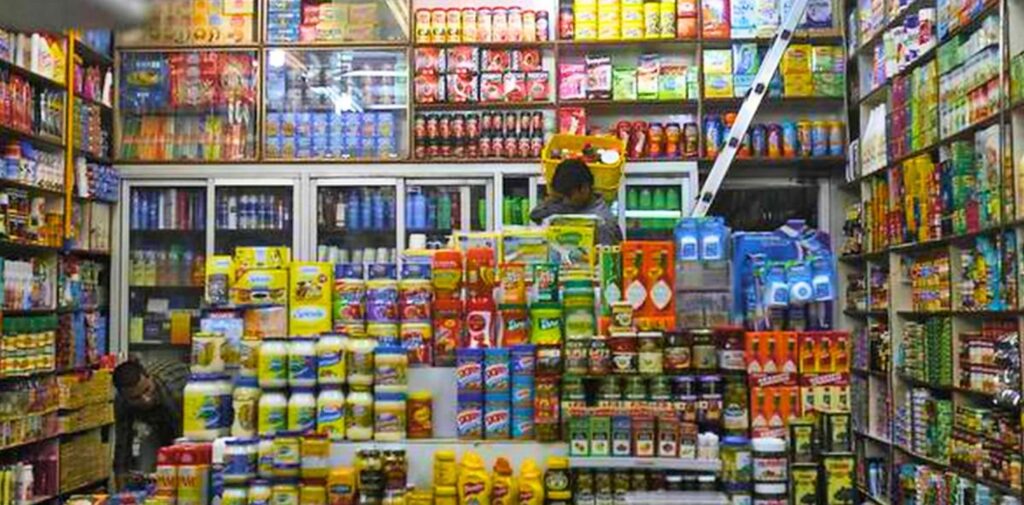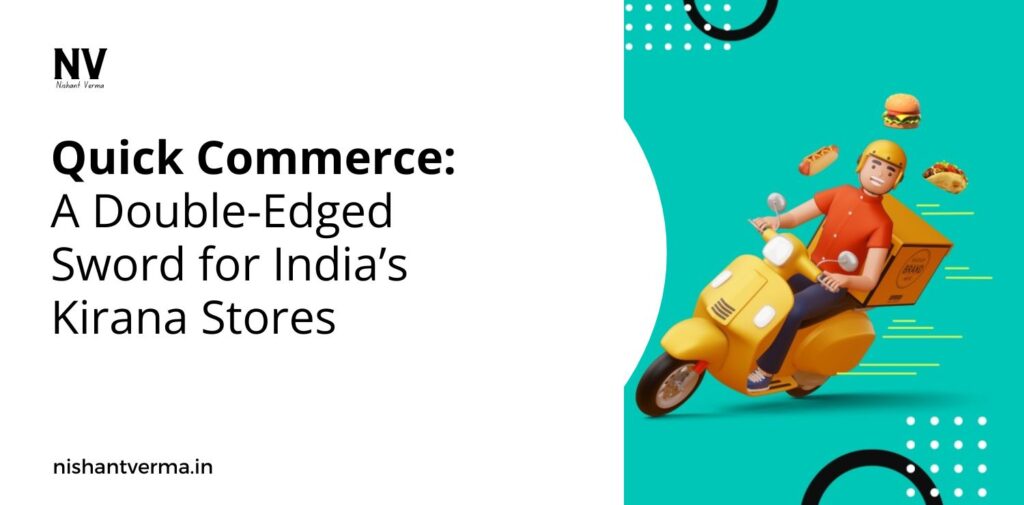India’s retail landscape, historically dominated by millions of small, family-owned kirana stores, is undergoing a massive transformation. Quick commerce—an ultra-fast delivery model that promises to deliver groceries and essential products in 10-30 minutes—has gained significant momentum in recent years. However, this rapid growth has come at a significant cost. The All India Consumer Products Distributors Federation (AICPDF) recently reported that over 200,000 kirana stores have been forced to shut down in the past year, a consequence of the battle for survival against the rise of quick commerce players. This development has raised serious concerns about the future of traditional retail in India, a sector that supports approximately 70% of the Indian economy.

Quick Commerce: The Disruptor
Quick commerce is not just a new trend in India; it is a disruption that is rewriting the rules of consumer behavior. Companies like Blinkit, Zepto, and Dunzo have emerged as key players in the quick commerce space, offering consumers the convenience of getting daily essentials delivered to their doorsteps in record time. The model is built on leveraging technology, an efficient supply chain, and extensive inventory management, all of which enable these services to meet consumer expectations for speed and convenience.
In a country as vast and diverse as India, where busy lives and hectic schedules have made online shopping increasingly attractive, the quick commerce model has found a fertile ground for expansion. The pandemic acted as a catalyst for this growth, with many consumers shifting to digital-first purchasing habits. This trend continues to gain steam, especially in urban areas, where the convenience of instant deliveries has led to a rapid adoption of these services.
However, this growth has not come without consequences for small businesses. Kirana stores, which have long been the backbone of Indian retail, are struggling to compete with the swift rise of these tech-driven giants.

The Impact on Kirana Stores
Kirana stores are more than just retail points; they are integral to India’s socio-economic fabric. They form the crux of local economies, providing employment to millions and offering a personalized shopping experience that large retailers and e-commerce platforms often struggle to replicate. In fact, the Indian retail sector is worth over $1 trillion, and kirana stores contribute a significant chunk to this, with estimates suggesting they account for around 70% of the retail market.
The onset of quick commerce has put a huge strain on this sector, especially in metropolitan areas. The increasing presence of platforms that promise hyperlocal deliveries and cater to the fast-paced lives of urban consumers has altered the dynamics of local trade.
As reported by the AICPDF, over 200,000 kirana stores closed their doors in the past year, signaling the dramatic impact of this disruption. These stores, many of which were small family-run businesses, have been unable to keep up with the competition presented by larger, more capital-backed quick commerce firms. A large number of kirana owners are finding it difficult to compete on price, product variety, or delivery speed, three of the main pillars that drive the quick commerce business model.
Moreover, the pandemic exacerbated the crisis. When lockdowns were imposed, online platforms flourished while traditional retail outlets, particularly kirana shops, were restricted or forced to limit their hours of operation. Many kirana stores were unable to pivot quickly enough to the digital space, which further diminished their competitive advantage. As a result, several small businesses were unable to recover their losses, forcing many to shut down.
Why Kirana Stores Are Struggling
Several factors contribute to the ongoing struggle of kirana stores in India:
- Lack of Technological Integration: Kirana stores, in general, operate on traditional methods of inventory management and cash-based transactions. While some are gradually adopting digital payments, they have been slow to integrate technology into their operations. This puts them at a clear disadvantage when compared to quick commerce platforms that use sophisticated algorithms and real-time tracking systems to manage inventory and provide quick deliveries.
- Price Competition: Large quick commerce players often have the leverage to negotiate bulk purchase discounts from manufacturers and suppliers, allowing them to offer products at prices lower than those available in local kirana stores. This price difference is hard to beat for small store owners, who have limited bargaining power and cannot afford to match the pricing strategies of their larger counterparts.
- Delivery Speed and Convenience: Convenience is a key driver of consumer behavior, and quick commerce has capitalized on this shift. While kirana stores may offer personalized service and the benefit of being local, they simply cannot compete with the hyperlocal, on-demand delivery service that is provided by quick commerce platforms. Consumers can now order products from the comfort of their homes and have them delivered in minutes, a level of convenience that traditional stores cannot replicate.
- Changing Consumer Behavior: The younger, tech-savvy demographic is now increasingly looking for instant gratification, which has led to a shift away from traditional brick-and-mortar shopping. Consumers are increasingly prioritizing convenience over the traditional shopping experience. In cities where quick commerce is growing, kirana stores are finding it difficult to adapt to this evolving consumer expectation.
- Rising Costs: The operating costs for small retailers have been rising steadily over the past few years, due to inflation, increasing rental rates, and a surge in logistics costs. These rising costs, combined with shrinking margins, make it difficult for kirana owners to stay afloat.

A Boon or Bane for India’s Economy?
The closure of kirana stores and the rise of quick commerce raises several questions about the future of India’s retail landscape. While quick commerce presents undeniable convenience for consumers, it is crucial to examine its broader socio-economic implications.
Job Losses: Kirana stores are vital to India’s employment landscape. Millions of people, from shop owners to delivery personnel, are employed in this sector. As quick commerce gains dominance, many of these workers are at risk of losing their jobs, as automation and larger platforms replace the need for manual labor in traditional retail settings.
Impact on Local Communities: Kirana stores play an essential role in serving their local communities. Many customers have personal relationships with the shop owners, who provide trusted products and services. The closure of these stores erodes this sense of community, leading to a more transactional and less personal retail experience.
Economic Imbalance: Quick commerce platforms, by virtue of their technology-driven business models, often operate in a manner that benefits urban, digitally literate populations. Rural and semi-urban areas, where kirana stores continue to thrive, are not as well-served by quick commerce. If the rapid growth of these platforms continues unchecked, it could exacerbate regional economic disparities, as smaller towns and rural areas are left behind in favor of bigger cities.
The Way Forward: Can Traditional Retail Survive?
While the rise of quick commerce seems unstoppable, the solution may not necessarily lie in the demise of kirana stores. Instead, a hybrid model could be the way forward—one where traditional stores embrace technology, streamline operations, and adapt to the evolving consumer needs.
For instance, some kirana stores are already partnering with e-commerce platforms to offer home delivery services or using digital tools to improve inventory management and pricing strategies. This hybrid approach could help them retain their customer base while also reaching new consumers who demand faster service.
Moreover, it is crucial for policymakers to step in and ensure that the transition is smooth for small business owners. Regulations could be introduced to create a level playing field between traditional stores and quick commerce platforms, especially in terms of logistics, pricing, and access to suppliers.
Conclusion: What Does the Future Hold?
The rise of quick commerce is undeniably reshaping India’s retail landscape. However, as we witness the closure of 200,000 kirana stores, it is essential to ask: What does this mean for India’s small businesses? The economic contribution of these stores cannot be overstated, and their loss could have long-term consequences for the local economy.
So, what is your take on this issue? Should India embrace the future of retail with open arms, or is it time to take a step back and reconsider the consequences of disrupting a sector that has supported millions for decades? We would love to hear your opinion on the rise of quick commerce and its impact on India’s traditional retail sector.




